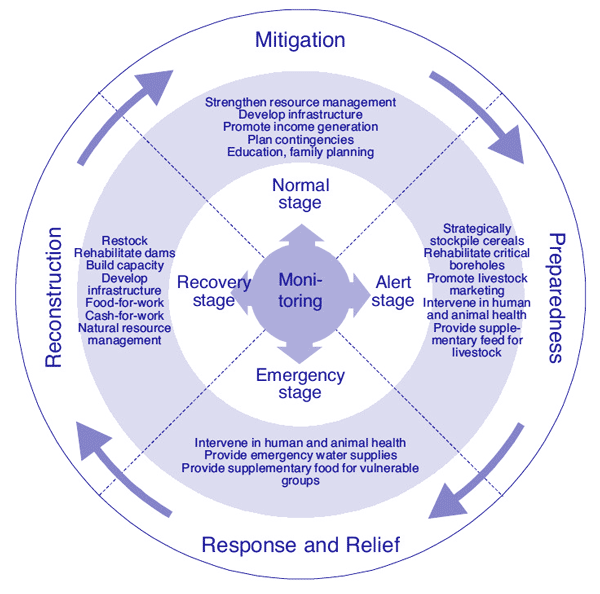Difference between revisions of "Drought cycle management"
| Line 1: | Line 1: | ||
[[Image:droughtcycle.png|thumb|right|400px|The drought cycle management. Source: IIRR, ACACIA & CordAid (2004) Drought Cycle Management: A toolkit for the drylands of the Greater Horn. p.41]] | [[Image:droughtcycle.png|thumb|right|400px|The drought cycle management. Source: IIRR, ACACIA & CordAid (2004) Drought Cycle Management: A toolkit for the drylands of the Greater Horn. p.41]] | ||
| − | + | __NOTOC__ <small-title /> | |
This article is part of a section on [[Resilient WASH systems in drought-prone areas|resilience of WASH systems]]. | This article is part of a section on [[Resilient WASH systems in drought-prone areas|resilience of WASH systems]]. | ||
Revision as of 05:27, 20 December 2013
This article is part of a section on resilience of WASH systems.
Droughts occur regularly and should not be seen as one-off occurrences – rather they should be planned for in order to reduce negative effects. Drought Cycle Management (DCM) describes in a general way how to reduce vulnerability (& increase resilience) of populations to drought through proper planning. The aim is also to use funds more effectively: making existing systems more resilient during the normal and alert stages means that less money should have to be spent during the emergency phase. Oxfam for example found that in drought-prone ASAL areas, development work is increasingly disrupted and/or undermined by the shift to emergency response.
As the diagram shows, the cycle consists of the following four stages
1) Normal stage - mitigation
- Strengthen resource management
- Develop infrastructure
- Promote income generation
- Plan contingencies
- Education, family planning
2) Alert stage - preparedness
- Strategically stockpile cereals
- Rehabilitate critical boreholes
- Promote livestock marketing
- Intervene in human and animal health
- Provide supplementary feed for livestock
3) Emergency stage - response and relief
- Intervene in human and animal health
- Provide emergency water supplies
- Provide supplementary food for vulnerable groups
4) Recovery stage - reconstruction
- Restock
- Rehabilitate dams
- Build capacity
- Develop infrastructure
- Food-for-work
- Cash-for-work
- Natural resource management

